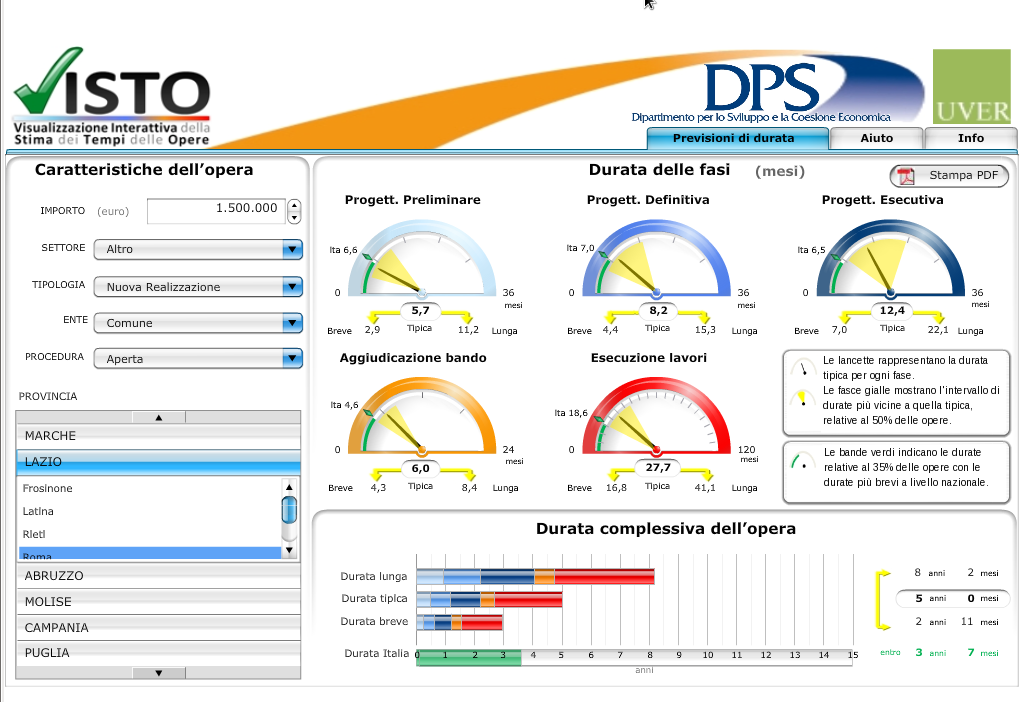Italian e-gov service helps to see why Public Sector Information should be open
On March 15, 2011, the VISTO website from the Italian Ministry of Treasury went online. VISTO that may be roughly translated to English as “(have you) SEEN?” is the acronym of “Visualizzazione Interattiva della Stima dei Tempi delle Opere”, which means more or less “Interactive Visualization of Duration Estimates of Public Works”. The portal provides an estimate of how much time passes, on average in each Italian Province, from the moment a tender is approved to the moment when the corresponding public work (roads, health services, whatever) is finished. The estimates include the average duration of each main phase of the projects.
According to the official website, VISTO generates its diagrams and reports in real time, by processing measures from the monitoring checks made in the field, according to statistical models that take into account cost, area and type of the work. A fairly complete (Italian only) FAQ provides much more details.

In practice, if you ask VISTO about the average duration of the public works in a certain cost bracket and in a certain province (the examples here are what I got for works with a 1.5 million Euros cost, in the province of Rome), you’ll get simple, friendly dashboards or downloadable PDF reports that contain all the data mentioned above.
VISTO is a very useful service and I thank its developers for it. At the same time, however (and this is certainly NOT the developers' fault!) VISTO is also an excellent demonstration of the limits of the standard way to build digital public services, in Italy and many other countries.
How can VISTO answer the questions made by citizens through their browsers? By querying (as explained in the FAQs) “the main official databases that store data about more than 40000 public projects”. And this is exactly where the limit of VISTO is.
If somebody in the Italian Ministry of Treasury realized that synthetic summaries of all those data are useful to citizens and found the money to provide those reports online, that’s an excellent thing. Point is, all those data used to build those fancy dashboards and reports are public. VISTO is a welcome service, but why don’t they also put online all those raw numbers?
That would make a huge substantial difference. Here’s why. Conceptually, veryfing the costs and completion times of public works through a website like VISTO is just like asking the same question to a public employee that, instead of letting you read and copy the original data by yourself: goes alone into some reserved room to read them on your behalf; does all the math and draws all the diagrams; then comes back to the counter, to give you only the final, one page summary. If you need other data, you have to start over.
But what if that clerk had done some mistake? What if I, the citizen, wanted to correlate and process those (PUBLIC!) data in ways that are different from the only ones that clerk was trained to do? What if I wanted to merge those data with digital maps or any other kind of data from others, unrelated sources, to understand better what they mean? Why can’t Italian citizens do this and must be forced to only ask the questions that VISTO is able to answer, without even veryfing if it made some mistake?
What if, instead, the raw numbers that VISTO uses to do its calculations and diagrams were all directly accessible through the Internet (and why they shouldn’t? Are they or not public data generated with taxpayers money to serve them and don’t even create any privacy problem?)? What would happen in such a scenario?
What would happen is that every private citizen, business or professional association, Chamber of Commerce, NGO, Judge, journalist and so on, could still use VISTO as intended by its developers. But they could also use any other software of their choice to analyze the same data and mix them with others, in any way that is more convenient for them. They could perform any conceivable analysis of those data, not just the ones that the VISTO developers hard-coded in the software, and they would do all that with their own money. Would that be bad?
What we have here is the same basic issue behind the “How long do Italians really live?" case, and dealt with in the Open Data, Open Society report: why aren’t the data behind VISTO and, in general, all Public Sector Information (PSI) that doesn’t create privacy problems, always published online by default?
PS for citizens of the EU-15 countries: if you care about transparency and the other topics mentioned in the Open Data, Open Society report, please tell your City and Region administrations to take the Open Data online survey!
Who writes this, why, and how to help
I am Marco Fioretti, tech writer and aspiring polymath doing human-digital research and popularization.
I do it because YOUR civil rights and the quality of YOUR life depend every year more on how software is used AROUND you.
To this end, I have already shared more than a million words on this blog, without any paywall or user tracking, and am sharing the next million through a newsletter, also without any paywall.
The more direct support I get, the more I can continue to inform for free parents, teachers, decision makers, and everybody else who should know more stuff like this. You can support me with paid subscriptions to my newsletter, donations via PayPal (mfioretti@nexaima.net) or LiberaPay, or in any of the other ways listed here.THANKS for your support!